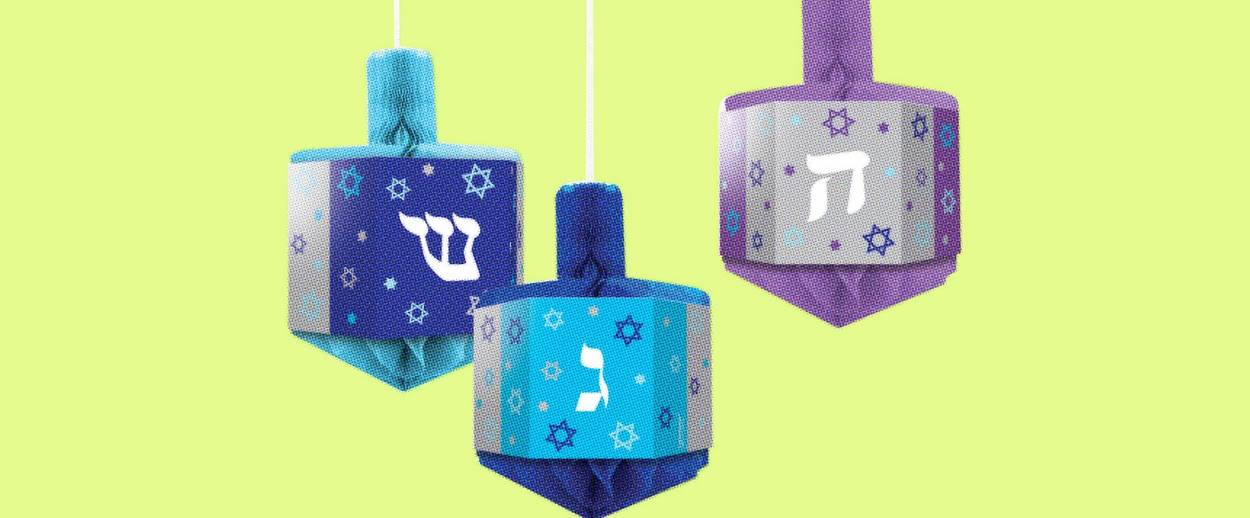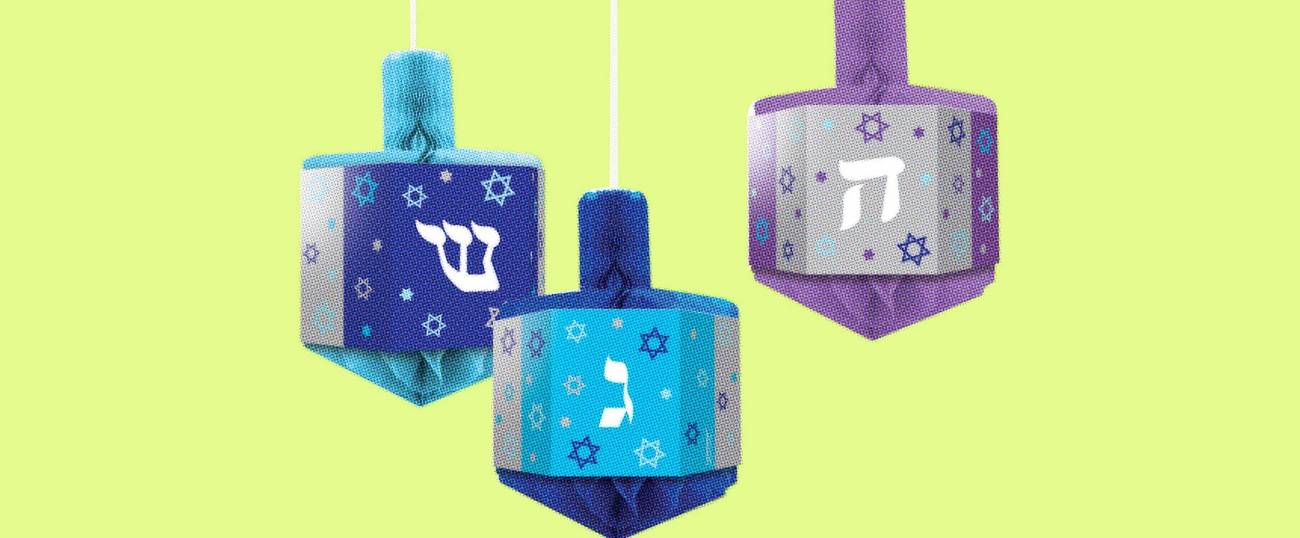Deck the Halls—With Paper Dreidels
How American homes came to embrace mass-produced Hanukkah decorations




“Deck the halls with boughs of holly, Fa-la-la-la-la-la-la-la-la,” trills the well-known Christmas anthem, encouraging those who celebrate the holiday to go all-out in decorating their homes for the occasion. Opportunities abound: There’s the tree, of course, as well as the ornaments that enliven its branches; table toppers; wreaths; and Christmas stockings and greeting cards galore to populate the fireplace mantel. Come December, many American domiciles are awash in accoutrement.
At the time “Deck the Halls” made its debut in the United States of the late 19th century, American Jews with a hankering for holiday décor were encouraged to think of Sukkot, not Hanukkah, as the answer to their prayers. What with erecting and decorating a synagogue sukkah, or festooning its sanctuary with “rotund pumpkins” and other examples of America’s vegetal bounty, the age-old autumnal festival lent itself to creative expression, where Hanukkah, that “minor festival,” a poor cousin of a holiday, did not.
Little by little, though, the aesthetic allure of Sukkot receded, while the appeal of the Maccabean festival increasingly took hold of the American Jewish imagination, looming larger and larger on the American Jewish calendar. By the 1950s, Hanukkah was well on its way to becoming a “major competitive winter sport,” acknowledged one suburban parent. Emerging from out of the gloom to which history and custom had consigned it, the Americanized Hanukkah became as shiny as the newfangled chromium menorahs now widely available in the marketplace.
Playful and spirited, an opportunity for laughter rather than lament, for fun and games in lieu of the more characteristic display of somber, restrained spirits, Hanukkah in postwar America enabled the Jews to turn over a new leaf, to embrace lightheartedness.
It took some doing, at least at first. Those American Jews eager to deck the halls of their suburban homes with appropriate Hanukkah décor—which was what, anyway?—had either to rely on their own facility with arts and crafts or turn to Jewish home institutes of the late 1940s and early ’50s for an assist. Aligned with the synagogue sisterhood or the local bureau of Jewish education, these prototypes of adult learning were designed to provide young American Jewish housewives of the time with the know-how to make their homes overtly, and happily, Jewish.
“There are so few ready-made decorations for Hanukkah one can purchase,” noted the “syllabus” of Buffalo’s Hanukkah Holiday Institute for Jewish Mothers in 1947, adding “what fun would that be anyway?! So with family cooperation, a little creativity and materials such as crepe paper, paste, etc., it is surprising how well we can express our ideas.”
To further that goal, hand-drawn instructions for wall streamers and large-size Jewish stars followed in quick succession: “One length of crepe paper will make one triangle of star—Cut 3 more strips and proceed same way for second triangle—Staple together—Sprinkle with silver dust.”
It didn’t take long before the manufacturers and distributors of Jewish ritual artifacts—among them, Shulsinger Brothers Inc., a longtime, New York City-based publisher of Jewish books and Hebrew school supplies—came to the rescue of those Jewish mothers who were less than nimble with a pair of scissors, “crepe paper, paste, etc.” by generating a wealth of holiday decorating items. These novelties ran the gamut from window stencil sets of Stars of David to silver foil mobiles of wreaths and oil jugs.
If Shulsinger Brothers Inc. had its way, the modern American Jewish consumer would also be able to envelop the family’s gifts in wrapping paper and ribbons festooned with dreidels and menorahs—and for good measure to plant a “Do Not Open Until Hanukkah” seal on each one. She might adorn her holiday table with coordinated sets of cups, plates, tablecloths, and napkins, in both cocktail and luncheon sizes, nearly every inch of which was decorated with stylized menorahs and olive branches.
As for what to put on the table and in everyone’s mouth, there were giant-size lollipops with the words “Shalom” or “Chanukah” printed on their surface; “nosh boxes” in the shape of pointy dreidels with handles that contained hard candies inside, and a boxed assortment of milk chocolate Maccabees sporting beards, grim smiles, and protective shields.
At a time when suburban Jewish homes, as well as postwar synagogues, were quick to adopt the sleek, unfussy styles associated with midcentury design, it’s hard to know what to make of these novelty items that were anything but. How did American Jewish women who delighted in their Russell Wright dishes, whose “intriguingly drab” shade of mustard delighted the gurus of modernism, reconcile their newly acquired aesthetic sensibility with kitschy “product lines for the Jewish home.”
The short answer: They didn’t. Modern design was one thing; Jewish design another. Sensitive to the marketplace, Shulsinger Brothers Inc. might tout the virtues of its made-in-Israel Hanukkah menorahs that featured a boy and girl in contemporary dress holding up a plaque bearing the words of “Maoz Tzur” in Hebrew script, or pivoted on the figure of a Maccabee, one hand resting on a jug of oil, the other clutching a shield. These items, proclaimed the company’s catalog, “depict the modern trend in design.”
More a matter of wishful thinking or a copywriter’s flourish, Shulsinger’s menorahs couldn’t hold a candle to the stylishly geometric accessories then in vogue. Perhaps when compared with 18th-century European brass menorahs, they merited the designation of “modern,” but when seen in the company of midcentury objet d’art, they missed by a mile.
And therein lies a holiday tale all its own: the low expectations American Jews, then, as now, bring to their Jewish ritual objects. We don’t expect much of them—and in turn, our expectations are rewarded. With a few exceptions here and there, mass-produced Judaica remains stubbornly subpar and lackluster. If only it were otherwise …
Fa-la-la.
***
Like this article? Sign up for our Daily Digest to get Tablet magazine’s new content in your inbox each morning.
Jenna Weissman Joselit, the Charles E. Smith Professor of Judaic Studies & Professor of History at the George Washington University, is currently at work on a biography of Mordecai M. Kaplan.